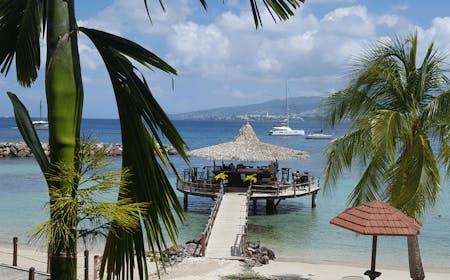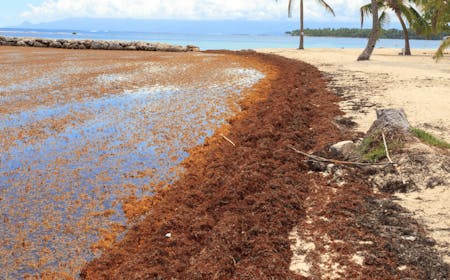
Martinique island : Discovering the island of flowers
The beautiful sandy beaches of the Caribbean Sea is why over half a million visitors flock to the stunning ...
Martinique is a small island, of 1 100 km2, composed of 34 communes for 376 480 inhabitants. It is part of the Volcanic Arc of the Lesser Antilles. A real earthly paradise, you have surely already heard about it. I will be surprised if you haven't.
Martinique is a DROM meaning Overseas Department and Region. Its culture is a splendid fusion of French and Creole culture. Always a touch of authenticity with a touch of modernity, you are sure to love it!
Between paradisiacal beaches, lush forest and colonial heritage, the island of flowers has everything to offer to those who are looking for sweet moments in the sun.
This page lists a set of information about the island of Martinique. You will find its communes, the different maps, its history or its geographical density.
If your trip to Martinique is booked, all you have to do is pack your suitcase. Martinique has a tropical climate, like the rest of the West Indies. Temperatures are therefore pleasant all year round. Between June and November the climate is hotter and more humid with occasional tropical rains. And between December and May the temperatures will be milder and the climate dry. In your suitcase, you will take summer clothes.
You will take light clothes that can be worn to go to the beach or to visit the flower island and do activities. So pack your favorite dresses, shorts, tank tops and t-shirts for this beautiful tropical trip. Remember to take something a little warmer, for example for air conditioning in restaurants or for hiking at altitude. Don't forget to bring a bathing suit, flip-flops, comfortable shoes, a cap, sunglasses and especially sunscreen.
Finally, if you wish to discover the sea bed, remember to bring a mask and snorkels. And to immortalize your most beautiful memories of Martinique and the Caribbean, don't forget your camera and possibly a camcorder.
If you are a citizen of the European Union, you will need a valid passport or national identity card to go to Martinique. For Swiss nationals, a passport is required. Moreover, the passport will be necessary if you intend to make an extension in the English-speaking islands of the surroundings. A visa is not required for stays of less than 90 days for European Union citizens and Swiss citizens.
The currency used in Martinique is the Euro since Martinique is a French Overseas Department. The American dollar can also be accepted, although this is rarely the case. Credit cards and traveler's checks are accepted. As far as electricity is concerned, it is 220 volts with the same plugs as those used in France, so it is not necessary to bring an adapter.
To travel in Martinique, some vaccinations are recommended. These include tetanus, diphtheria, hepatitis A and B, poliomyelitis and whooping cough. As for yellow fever, the vaccine is not mandatory if you come from Europe or the United States.
However, if you are coming from a country where the disease is active (sub-Saharan Africa and South America), this vaccine may be required just like in metropolitan France. This is the case for Bolivia, Peru, Argentina, Paraguay, Ecuador, Colombia, Brazil, Guyana and Venezuela. For travelers coming from these countries, the vaccine may be useful for administrative reasons.
In any case, it is important to check the regulations before the trip. Martinique and the Caribbean in general being in a tropical climate zone, there is a risk of dengue, Zika and chikungunia. It is therefore advisable to take the necessary measures to avoid mosquito bites (mosquito repellents, mosquito nets). On the other hand, no worries with malaria which has disappeared on the island!
During the COVID period, the instructions and restrictions are likely to change and be modified. It is therefore necessary to be informed before departure about travel arrangements (PCR test, health pass...).
You will find on this article, a table of the average budget for each category of expenses (air tickets, accommodation, catering, etc....) in order to give you a more or less precise idea of the budget you should plan for your trip.
If you want to go between February and April or June and August, you should plan at least 3 months in advance in order to have attractive prices.

In terms of accommodation, you will be spoiled for choice: private villas, 4-star hotels, hotel residences, apart hotels, bed and breakfasts, unusual accommodations or even Airbnb rentals, all you have to do is make a hole in the wall! In the meantime, discover our top 5 hotels on the island.
Martinique is full of restaurants for all tastes! And this, for a fascinating quality/price ratio. We invite you to discover our article on the 8 restaurants we recommend for a total gustatory and cultural immersion.
For a complete stay, we advise you to make a circuit starting from the center, towards the north and to finish in beauty on the beautiful beaches of the south! We have prepared a circuit to optimize your stay of 10 days on the island.
|
Type |
Information |
|
Hospitals |
|
|
Private clinics |
|
|
Prefecture |
Blanc BP 647/648 97262, Rue Louis, Fort-de-France, Martinique |
|
Central Police |
3 Rue Victor Sévère 97200 FORT DE FRANCE |
|
Emergencies |
|
|
The tourist offices |
|
Christopher Columbus landed on the island of flowers on June 15, 1502, at the present location of the commune of Carbet. At that time, Amerindian peoples had been living on these lands for a long time. The oldest traces date from 2400 to 1900 B.C., but it is possible that it was earlier.
In 1635, the French took possession of the island with the landing of the buccaneer Pierre Belain d'Esnambuc. They first settled in the western part of the island. They then founded Fort Saint-Pierre and Fort Royal which would become Fort-de-France.
There are tensions and conflicts on the island between the colonists and the Indians who were living there when they arrived. The Indians were massacred and those who managed to escape took refuge in Dominica and Saint Vincent.
On the island of flowers the colonists cultivated sugar cane, tobacco, indigo, cocoa and coffee. But this agriculture required slavery and the trade of blacks from Africa. The first slaves arrived in 1641.
Slavery developed greatly between 1671 and 1674, exploding from 1680. We then see a real triangular trade (Africa, Europe, America) linked to the massive cultivation of sugar cane and other local products. During the revolution of 1848, the slaves of the West Indies demanded the abolition of slavery.
They obtained it on May 27, 1848. Since 1946, Martinique is a French overseas department. The island owes its name to the Caribbean Indians. It is a derivative of the names they used to designate these lands "Madiana", "Madinina" or "Mantinino".
The city of Saint-Pierre or "Little Paris of the Antilles" is located in the northwest of Martinique. This town is the former administrative, economic and cultural capital of the island (chief town).
It was also the economic and cultural "capital" of the island until 1902, when it was destroyed by the eruption of the Pelee.

What you need to know is that the island of flowers has 3 flags. Each one has its reasons to be, its meaning and its history. Each one is more fascinating than the other. So let's go for a good Creole history lesson: the flags of Martinique
Fort-de-France is the largest city in Martinique, and also the most populated. Did you know that the city was called Fort-Royal until the early 1800s? That's probably why its inhabitants are called the Foyalais. As you may have guessed, the city was first a Fort, built in 1639. Fort Royal became a city in 1669. During its colonial history, the city was occupied in turn by the French and the British. The city was finally named Fort-de-France in 1807 and keeps its name until today.
If you have read some of our articles, you may have seen that Saint-Pierre was the main city of Martinique. Until it was tragically destroyed by the famous eruption of the Mount Pelee volcano. Info: Fort-de-France had Mr. Aimé Césaire as mayor of the city from 1945 to 2000... Elected and re-elected for 56 years, we can say that he was very "loved"!

The island of flowers has many communes (cities), each one more charming than the other.
To get to the island of flowers from France, you have direct flights. It takes 8 to 9 hours of flight. You will have a 5 hour time difference in winter and 6 hours in summer.
When you arrive at the island, the best thing is to have a vehicle. You will be able to travel around the island of flowers and discover the most beautiful landscapes of the Caribbean. Renting a car is therefore the perfect solution for a small road-trip. You will be autonomous to visit, do activities, go to the beach and go out at night.
The roads are in good condition and sometimes winding, which gives them a lot of charm. However, during rush hour and high season, traffic can be heavy, especially around Fort-de-France. Remember to book a rental car before you leave, especially in high season. By booking in advance, you will have more choices and a better price.
If you don't want to rent a car, you can also use cabs. Agree with the driver on his rates before departure if he does not have a meter.
Another alternative is to rent a scooter or a motorcycle. And the sportsmen will be able to choose a bicycle rental to discover the green landscapes of the Antilles while pedaling.
There are no particular dangers on the island. It is advisable, as everywhere else in France and elsewhere, to avoid, for example, hanging out alone at night in dark streets. On the road, the traffic being sometimes dense, it is necessary to be vigilant and drive carefully. Concerning the environment, rules must be applied in order to respect the ecosystem. Water has become precious and should not be wasted. At the hotel, change only the towels that need it.
To avoid over-consumption of energy, do not use the air conditioning in your room all the time. Do not throw plastic or other waste into the environment. If you come across animals, do not disturb them. If you go exploring the island, do not cut or tear up flowers or plants. If you are exploring the island, do not cut or remove any flowers or plants, and do not pick up any rocks or fossils as souvenirs.


The beautiful sandy beaches of the Caribbean Sea is why over half a million visitors flock to the stunning ...

Sargassum is a brown algae, scientifically called sargassum. The deposits can be up to a meter thick and al...

The lobster, just by pronouncing this word, your mouth is watering, at least for those who like shellfish a...